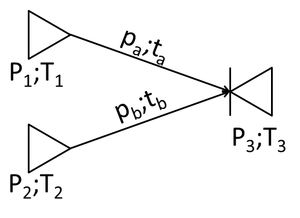Graphical Evaluation and Review Technique
| Graphical Evaluation and Review Technique |
|---|
| See also |
Graphical Evaluation and Review Technique (GERT) is one of the network charts. The method was created in early sixties and first described by Alan B. Pritsker in 1966. His publication remains the most popular and accessible description of GERT (see references for link). The main application of the method are poorly defined, highly probabilistic R&D projects, where there can be many alternative paths and loops.
GERT vs. other network diagrams
Its much less popular than PERT (Program Evaluation and Review Technique) or CPM (Critical Path Method). However it has can offer much more than those methods. PERT or CPM are very popular in most projects, but they have their limitations. The main are:
- there are no alternative paths - all activities have to be performed
- there are no loops - it is not possible to repeat activity, next similar activity has to be added
- there are no decisions in the diagram - no and, or, xor options which help to choose proper path
- there are no scaling - it is not possible to replace some detailed group of activities with the one summary task.
GERT doesn't have those limitations. But it comes at a cost of more sophisticated diagram.
General GERT rules
GERT uses activity-on-arrow notation only. That means that each activity is described on arrow. The nodes are used to connect activities, but also to determine type and conditions of relations between them.
Each task has two parameters: duration and probability of appearance.
There are three logical operators in GERT which concern activities incoming to the node:
- XOR - alternative (only one path possible)
- OR - alternative (one or more paths can be performed)
- AND - all paths have to be performed
The most common is AND, which means that every incoming activity has to happen before the outcoming one start.
There are also two types of relations that concern activities outcoming from the node:
- deterministic - every outcoming activity has probability equal to 1, which means that every one will be performed
- probabilistic - each outcoming activity has some probability of appearance.
Each node consists of one logical operator and one relation, which gives six combinations:
GERT example
In this example two space vehicles are being sent and meet in the space. The success of the mission is possible only if both are successfully launched.
Mission success has AND operator, as both vehicles are required. But mission failure has OR operator, as if at least one of them fails, the mission fails.
The example comes from A.A.B. Pritsker publication (see references).
Loops
The example below shows simple loop. The activity can be performed for the first time or (XOR) for the next time. Thus XOR in the beginning. If the result of the activity is not acceptable, the activity is repeated. The probability of repeating can be calculated.
Time and probability calculation
Calculation of duration requires analysis of probability and duration.
The equations below show how to calculate probability and duration of arriving at node 3 from nodes 1 and 2, which are alternative.
References
- Pritsker, A. A. B. (April 1966). GERT: Graphical Evaluation and Review Technique. National Aeronautics and Space Administration under Contract No. NASr-21.
- Wolpaw, J. R., Birbaumer, N., McFarland, D. J., Pfurtscheller, G., & Vaughan, T. M. (2002). Brain–computer interfaces for communication and control. Clinical neurophysiology, 113(6), 767-791.
- Kurihara, K., & Nishiuchi, N. (2002). Efficient Monte Carlo simulation method of GERT-type network for project management. Computers & Industrial Engineering, 42(2), 521-531.





